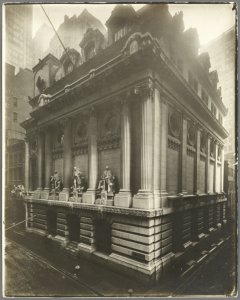The Greenwich Village Theatre only existed for thirteen years, but within that time frame the institution established a lasting legacy within the theater world and in Greenwich Village. Originally designed and built by New York architect Herman Lee Meader, the 500-seat theatre was a landmark of Greenwich Village from 1917 to 1930.
Located on the west side of Seventh Avenue South between Christopher and West 4th Streets overlooking Sheridan Square, the Greenwich Village Theatre was originally built for the Greenwich Village Players, an acting troupe founded by Frank Conroy and featuring a young Clare Eames. The Greenwich Village Players reflected the prevalence of “little theatres” during the teens, in which theatre enthusiasts transformed into amateur actors and playwrights and eventually theater professionals.
Despite being known as a locale of bohemia and radicalism, Greenwich Village was also a popular tourist destination during the 1910s and 1920s. The area of Sheridan Square was particularly popular among tourists, due to the development of the west side subway line in 1918. Originally published in the Saturday Evening Post, Sinclair Lewis satirized the influx of tourists in “Hobohemia,” a short story that he adapted into a play that ran at the Greenwich Village Theatre in 1919. The play features the characters of Mr. Brown and Mrs. Saffron. Mr. Brown “decides the only problem with bohemia is that the bohemians don’t know how to make a profit from it,” and encounters Mrs. Saffron, a parody of Mabel Dodge, in Greenwich Village. Lewis’s play satirized prominent Greenwich Village figures, who he clearly thought were taking themselves too seriously. This transition from the serious bohemian theatre troupe of the Greenwich Village Players to an increased willingness to parody themselves set the stage for the Greenwich Village Follies.
The Greenwich Village Follies premiered on July 15, 1919 at the Greenwich Village Theatre. Though initially titled “Greenwich Village Nights,” this was quickly changed to the Follies; facing off against the popular Ziegfeld’s Follies. Created by John Murray Anderson alongside lyricist Philip Bartholomae and composer A. Baldwin Sloane, the musical revue more than held its own against Ziegfeld’s Follies. Praised by the New York Times, particularly for its “melody and beauty,” the 1919 Follies emerged as a hit.
Much of the scenes and songs of the Follies parodied Greenwich Village life and current events. Bessie McCoy, the Broadway veteran, sang, “I’m a Hostess of a Bum Cabaret,” satirizing Prohibition, while other songs like “I’ll Sell You a Girl,” poked fun at bohemian concepts such as free love.
Following the success of the 1919 Follies, Anderson produced another series of shows in 1920 that played at the Greenwich Village Theatre. However, the 1920 Follies greatly resembled a Broadway musical revue, and the show moved to the Schubert Theatre on Broadway a month after it opened. The Greenwich Village Follies played for six seasons on Broadway and became less associated with the Village after its second season.
Despite only running for less than two seasons in Greenwich Village, the legacy of the show has lasted. In 2011, a musical revue detailing Greenwich Village history billed itself as “The Greenwich Village Follies.” The show, performed at Manhattan Theater Source on Macdougal St., covered local history from the 1700s to the Stonewall rebellion in 1969.
After the departure of the Greenwich Village Follies, the Greenwich Village Theatre remained a landmark of Sheridan Square and the Village until 1930 when it was demolished.
Sources
Bordman, Gerald. American Musical Theater: A Chronicle. Oxford University Press: 2001.
Gates, Anita. “From George Washington to Beatniks and Beyond.” NY Times, Jul. 3, 2011.
Hischak, Thomas S. Off-Broadway Musicals since 1919: From Greenwich Village Follies to the Toxic Avenger. Scarecrow Press: 2011.
Strausbaugh, John. The Village: 400 Years of Beats and Bohemians, Radicals and Rogues, a History of Greenwich Village. Harper Collins: 2013.



























You must be logged in to post a comment.